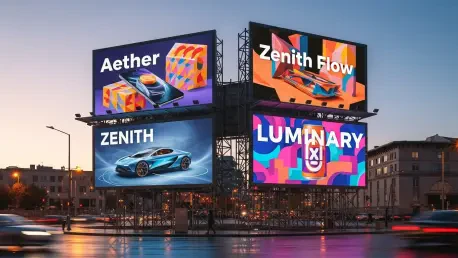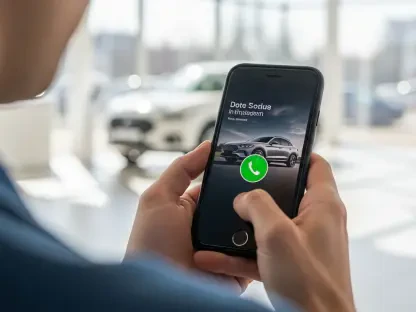I’m thrilled to sit down with Anastasia Braitsik, a global leader in SEO, content marketing, and data analytics, whose expertise extends into the dynamic world of digital out-of-home (DOOH) advertising. With a deep understanding of how digital strategies intersect with traditional media, Anastasia offers a unique perspective on the evolving advertising landscape, particularly in the Saudi Arabian market. In this interview, we’ll explore the transformation of out-of-home (OOH) advertising, the innovative impact of DOOH, and how brands can leverage these platforms to cut through the clutter and connect with audiences in meaningful ways.
How has your extensive background in digital marketing and data analytics shaped your perspective on the evolution of out-of-home advertising, especially in a market like Saudi Arabia?
My journey in digital marketing has given me a front-row seat to how technology transforms communication, and that’s been especially evident in the OOH space in Saudi Arabia. When I started, OOH was mostly static billboards with limited reach. Over the years, I’ve seen it evolve into a powerhouse with digital formats that offer real-time data and insights. In Saudi Arabia, the rapid digitization—think Digital Bridges and iconic facades like Kingdom Tower—has turned public spaces into interactive canvases. My analytics background helps me appreciate how these advancements allow us to measure impact and refine strategies in ways we couldn’t before, making OOH a vital part of any integrated campaign.
What do you think has been the most significant shift in the OOH landscape in this region over the past decade?
Without a doubt, it’s the widespread adoption of digital out-of-home formats. A decade ago, OOH in Saudi Arabia was largely about traditional billboards with static messaging. Now, with large-scale digital displays on major highways and iconic buildings, the medium has become a spectacle that captures attention like never before. These formats don’t just display ads; they create experiences that people notice and share. This shift has redefined how brands engage with audiences, turning a passive medium into an active conversation starter.
In what ways has DOOH opened up new opportunities for advertisers compared to traditional OOH formats?
DOOH has been a game-changer by expanding reach and flexibility. Unlike static billboards, digital displays allow for dynamic content updates, so campaigns can adapt to current events or consumer trends in real time. It also attracts new advertisers who might not have considered OOH before because they can now target specific demographics with tailored messages. Plus, the ability to integrate offline visibility with online engagement—through QR codes or social media prompts—means brands can track and amplify their impact far beyond the physical location. It’s a level of interaction traditional OOH just couldn’t offer.
How does DOOH empower brands to push creative boundaries in their campaigns?
DOOH gives brands the freedom to experiment with storytelling in ways static formats never could. With digital screens, you can run animations, showcase live data feeds, or even interact with weather or traffic updates to make ads feel relevant and timely. For example, I’ve seen campaigns in Saudi Arabia where brands change their messaging based on the time of day—think a coffee ad in the morning shifting to a dinner promotion by evening. This kind of creativity not only grabs attention but also builds a deeper connection with the audience because the content feels personal and in-the-moment.
Why do you believe OOH advertising continues to hold a critical spot in a brand’s media mix, even with the dominance of digital platforms?
OOH offers something digital platforms often can’t—unavoidable, real-world visibility. In a world where people can skip ads online or tune out with ad blockers, OOH stands out as a medium that can’t be ignored. It’s especially powerful in high-traffic areas like Riyadh, where a single display on a landmark can reach thousands in a day. Beyond that, it builds trust; studies show a significant portion of consumers view OOH advertisers as credible and feel informed by their messages. When paired with digital channels, it creates a synergy that amplifies both awareness and engagement.
Can you share an example of how a strong OOH campaign can spark online conversations and extend a brand’s reach?
Absolutely. Take a campaign on a landmark like Kingdom Tower in Riyadh. When a brand places a striking visual or message there, it doesn’t just reach the people driving by—it becomes a moment people photograph and share on social media. I’ve seen instances where such campaigns achieved massive recognition not just locally but globally through online buzz. That physical presence triggers digital chatter, extending the campaign’s life and reach far beyond the initial audience. It’s a perfect example of how OOH can act as a catalyst for broader engagement.
What’s the best approach for brands to integrate OOH with social media and other digital channels for a cohesive consumer experience?
The key is to create a seamless narrative across platforms. Start with a bold OOH presence that grabs attention and sparks curiosity—something visually striking or emotionally resonant. Then, embed elements like hashtags, QR codes, or calls-to-action that drive people to engage online, whether it’s joining a conversation on social media or exploring a landing page. The OOH component builds mass awareness, while digital channels allow for deeper, more targeted interaction. It’s about using each medium for its strength and ensuring the messaging feels connected, so consumers don’t feel like they’re jumping between unrelated experiences.
What is your forecast for the future of OOH and DOOH advertising in Saudi Arabia over the next few years?
I’m incredibly optimistic about the future of OOH and DOOH in Saudi Arabia. With the country’s rapid urbanization and focus on smart cities, I expect to see even more integration of technology into public spaces—think interactive screens, augmented reality features, and AI-driven content personalization. DOOH will likely become more data-centric, allowing for hyper-targeted campaigns based on real-time consumer behavior. At the same time, as Vision 2030 continues to drive infrastructure growth, we’ll see more iconic locations transformed into advertising hubs. It’s an exciting time, and I believe OOH will solidify its role as a cornerstone of innovative, impactful marketing strategies in the region.









